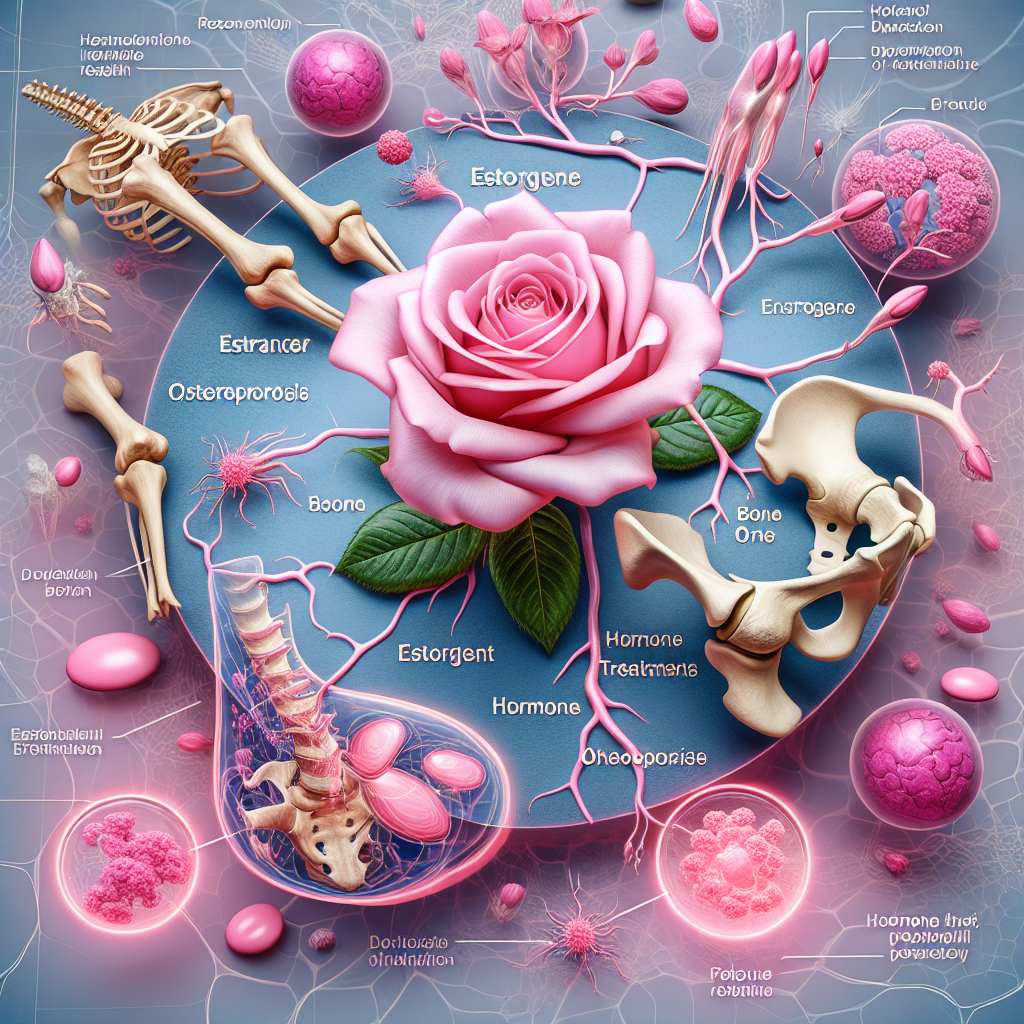Are you curious about the role hormones, particularly estrogen, play in the development of osteoporosis? Osteoporosis is a condition that weakens bones, making them more susceptible to fractures. In this article, we will explore the influence of hormones on bone health and delve into the specific role of estrogen in osteoporosis development. Additionally, we will discuss the various hormonal therapies available for the treatment of this condition. So, let’s dive into the fascinating world of hormones and their impact on osteoporosis!
Role of Hormones in the Development of Osteoporosis
Osteoporosis is a condition characterized by a decrease in bone density, leading to fragile and weakened bones. While the deterioration of bones is a natural part of aging, hormonal imbalances, particularly in estrogen and other hormones, can accelerate this process. Understanding the role of hormones in bone health is crucial for the development of effective treatments for osteoporosis.
Importance of Hormones in Bone Health
Hormones play a critical role in regulating bone homeostasis, which refers to the balance between bone formation and bone resorption. Estrogen, in particular, is important for maintaining bone health. It helps to slow down bone loss by inhibiting the activity of osteoclasts, which are cells responsible for breaking down bone tissue. Additionally, estrogen stimulates the activity of osteoblasts, which are cells that promote the formation of new bone. This delicate balance ensures that bone remodeling occurs in a controlled and continuous manner.
Estrogen and its Role in Bone Homeostasis
Estrogen is essential for bone growth and development throughout a person’s life. During puberty, estrogen triggers a growth spurt and contributes to the achievement of peak bone mass, which refers to the maximum amount of bone a person can attain. This is especially important for the prevention of osteoporosis later in life, as individuals with higher peak bone mass are at a lower risk of developing the condition.
Effects of Estrogen Deficiency on Bone Health
Estrogen deficiency, commonly seen in menopause, can have detrimental effects on bone health. As women undergo menopause, their estrogen levels decline significantly, resulting in an imbalance between bone resorption and formation. Without sufficient estrogen, the rate of bone resorption surpasses that of bone formation, leading to a higher risk of osteoporosis. Women can lose up to 20% of their bone density within the first 5-7 years after menopause.
Estrogen and Osteoporosis Risk
Decline in Estrogen Levels
The decline in estrogen levels is a natural part of the aging process in both men and women. However, women experience a more significant decline during menopause due to the cessation of ovarian function. Estrogen levels also decrease in men, but at a slower rate. These hormonal changes contribute to an increased risk of osteoporosis.
Menopause and Osteoporosis Risk
Menopause is a crucial period for women in terms of bone health. The rapid decline in estrogen levels during menopause causes accelerated bone loss. Studies have shown that women can lose up to 2-3% of their bone density per year during the first decade after menopause. This increased bone loss puts postmenopausal women at a higher risk of developing osteoporosis.
Hormonal Imbalance and Osteoporosis
Apart from menopause, other factors that contribute to hormonal imbalances can also increase the risk of osteoporosis. Certain medical conditions, such as primary ovarian insufficiency or hormonal disorders like hyperthyroidism and hyperparathyroidism, can disrupt the normal hormonal balance and lead to accelerated bone loss. It is important to address these underlying hormonal issues to prevent or manage osteoporosis effectively.

Other Hormones and Osteoporosis
Role of Progesterone in Bone Health
While estrogen plays a primary role in bone health, progesterone also contributes to maintaining bone density. Progesterone stimulates the activity of osteoblasts and promotes bone formation. It also helps to regulate the balance between bone resorption and bone formation. Therefore, an imbalance between estrogen and progesterone can have negative effects on bone health, especially during menopause when both hormone levels decline.
Importance of Testosterone in Maintaining Bone Density
Testosterone is commonly associated with male reproductive health, but it also has a significant impact on bone health in both men and women. Testosterone contributes to the growth and development of bones during puberty, similar to estrogen in females. In adulthood, it maintains bone density and reduces the risk of osteoporosis. Low testosterone levels in men can increase the risk of osteoporosis, highlighting the importance of hormonal balance in maintaining bone health.
Hormonal Therapies for Osteoporosis
Hormone Replacement Therapy (HRT)
Hormone replacement therapy (HRT) is a treatment option that involves supplementing the body with the hormones it lacks. In the case of osteoporosis, HRT typically involves the administration of estrogen to replace the hormone that has decreased due to menopause or other hormonal imbalances. It can help slow down bone loss and reduce the risk of fractures. However, the use of HRT is not without risks and must be carefully considered and monitored.
Selective Estrogen Receptor Modulators (SERMs)
Selective estrogen receptor modulators (SERMs) are medications that act as estrogen receptor agonists or antagonists depending on the specific tissue they target. They bind to estrogen receptors in certain tissues, including bone, and mimic the effects of estrogen. SERMs can help prevent bone loss and reduce the risk of fractures. However, like HRT, they also carry some risks and side effects.
Estrogen/Progestin Therapy
Estrogen/progestin therapy combines estrogen and progestin to mimic the hormonal balance found in premenopausal women. This therapy is often prescribed to women who have not undergone a hysterectomy. Progestin is added to reduce the risk of endometrial cancer associated with estrogen use alone. Estrogen/progestin therapy can help maintain bone density and reduce the risk of fractures. As with other hormonal therapies, it is important to consider the risks and benefits before starting this treatment.
Testosterone Therapy
Testosterone therapy may be considered for men with low testosterone levels that contribute to the development of osteoporosis. By supplementing testosterone, bone density can be improved and the risk of fractures reduced.

Benefits and Risks of Hormonal Therapies
Benefits of Hormone Replacement
Hormonal therapies, such as HRT and SERMs, have shown significant benefits in managing osteoporosis. These therapies can help slow down bone loss, maintain bone density, and reduce the risk of fractures. They also provide relief from menopausal symptoms, such as hot flashes and vaginal dryness. In addition to their positive effects on bone health, hormonal therapies can enhance overall well-being and quality of life for individuals undergoing treatment.
Risks and Side Effects of Hormonal Therapies
Hormonal therapies, while beneficial, have potential risks and side effects that need to be considered. Estrogen-based therapies, including HRT and estrogen/progestin therapy, have been associated with an increased risk of blood clots, stroke, and certain types of cancer, such as breast cancer and endometrial cancer. SERMs also carry certain risks, including an increased risk of blood clots and hot flashes. Therefore, it is crucial for healthcare providers to assess each individual’s medical history, risk factors, and overall health before recommending hormonal therapies.
Individualized Treatment Approaches
Tailoring Hormonal Therapy to Patient’s Needs
As with any medical treatment, a personalized approach is essential when it comes to hormonal therapies for osteoporosis. Factors such as a person’s age, overall health, medical history, and preferences should be taken into consideration. The decision to start hormonal therapy should be made in consultation with a healthcare professional who can assess the individual’s unique needs and risks.
Lifestyle Changes to Support Hormonal Treatment
In addition to hormonal therapies, certain lifestyle changes can support the effectiveness of treatment and help maintain bone health. These may include adopting a healthy diet rich in calcium and vitamin D, engaging in regular weight-bearing exercises, avoiding tobacco and excessive alcohol consumption, and maintaining a healthy body weight. These lifestyle modifications can complement hormonal treatment and further reduce the risk of osteoporosis-related fractures.

Non-Hormonal Therapies and Prevention Measures
Bisphosphonates
Bisphosphonates are a class of medications commonly used to treat osteoporosis. They work by slowing down bone breakdown and reducing the risk of fractures. Bisphosphonates can be prescribed as oral tablets or given intravenously. These medications are often the first line of treatment for postmenopausal women with osteoporosis and can also be used in men with the condition.
Raloxifene
Raloxifene is a selective estrogen receptor modulator (SERM) that is approved for the prevention and treatment of osteoporosis in postmenopausal women. It works by estrogen-like effects on bone, reducing bone resorption and improving bone density.
Calcitonin
Calcitonin is a hormone that helps regulate calcium levels in the body. It can be used as a treatment for osteoporosis, primarily for pain relief from vertebral fractures. Calcitonin slows down bone resorption and may help reduce the risk of new fractures.
Denosumab
Denosumab is a medication that inhibits the activity of osteoclasts, the cells responsible for breaking down bone tissue. It is administered as an injection and is effective in reducing bone loss and decreasing the risk of fractures in postmenopausal women with osteoporosis.
Teriparatide
Teriparatide is a synthetic form of parathyroid hormone, which plays a crucial role in regulating calcium and bone metabolism. It is administered as an injection and can stimulate bone formation, leading to increased bone density and reduced fracture risk. Teriparatide is used in the treatment of severe osteoporosis or in individuals who cannot tolerate other therapies.
Strontium Ranelate
Strontium ranelate is a medication used for the treatment of osteoporosis. It works by promoting bone formation and inhibiting bone resorption. Strontium ranelate is available in oral form and can reduce fracture risk in postmenopausal women with osteoporosis.
Nutritional Supplements
In addition to a healthy diet, certain nutritional supplements can support bone health and reduce the risk of osteoporosis. Calcium and vitamin D are essential for bone mineralization, and supplementing with these nutrients can help meet the body’s requirements. It is important to consult with a healthcare professional before starting any supplements.
Exercise and Physical Activity
Regular exercise, particularly weight-bearing and resistance exercises, helps stimulate bone formation and reduce the risk of osteoporosis-related fractures. Engaging in activities such as walking, dancing, weightlifting, and yoga can promote bone health and improve overall strength and balance.
Complementary and Alternative Medicine
Herbal Supplements
Some individuals may consider using herbal supplements as an alternative or complementary treatment for osteoporosis. Certain herbs, such as red clover, black cohosh, and horsetail, have been traditionally used for their potential bone health benefits. However, it is essential to approach herbal supplements with caution, as their safety and efficacy may not be well established. Consulting with a healthcare professional is advisable before incorporating herbal supplements into a treatment plan.
Acupuncture
Acupuncture, a traditional Chinese medicine practice involving the insertion of thin needles into specific points on the body, has been explored as a potential therapy for osteoporosis. While research on acupuncture’s effectiveness in treating osteoporosis is limited, some studies suggest it may help reduce pain and improve quality of life. As with any alternative therapy, it is important to consult with a qualified practitioner and consider it as part of a comprehensive treatment plan.
Tai Chi
Tai Chi, an ancient Chinese martial art that combines gentle movements and deep breathing, has been shown to improve balance, strength, and flexibility. Regular practice of Tai Chi may help reduce falls and improve bone health in individuals with osteoporosis. This low-impact exercise can be a beneficial addition to a comprehensive treatment plan.
Yoga
Yoga combines physical poses, breathing exercises, and meditation to promote overall well-being. Some yoga poses can help improve flexibility, strength, balance, and posture, which are key factors in maintaining bone health. Incorporating yoga into a regular exercise routine can be beneficial for individuals with osteoporosis.
Future Directions in Hormonal Therapy
Emerging Therapies and Research
Ongoing research is focused on exploring new hormonal therapies for the treatment of osteoporosis. This includes developing novel drugs that target specific hormonal pathways involved in bone metabolism. Researchers are investigating the potential of different hormone combinations, dosage regimens, and delivery methods to improve efficacy and reduce side effects. The goal is to find safer and more effective hormonal therapies that can effectively prevent bone loss and reduce fracture risk.
Advances in Targeted Hormonal Treatments
Advancements in targeted hormonal treatments for osteoporosis are promising. These therapies aim to selectively modulate specific hormonal pathways involved in bone health, minimizing potential side effects. Targeted treatments can offer improved efficacy and safety profiles, optimizing the management of osteoporosis.
Conclusion
Hormones, particularly estrogen, play a crucial role in the development and treatment of osteoporosis. Estrogen deficiency, typically seen during menopause, accelerates bone loss and increases the risk of fractures. However, other hormones, such as progesterone and testosterone, also contribute to maintaining bone density. Hormonal therapies, such as HRT, SERMs, and testosterone therapy, can be effective in managing osteoporosis, but they carry risks and side effects that need to be carefully considered. Personalized treatment approaches and lifestyle modifications, including exercise and nutrition, are essential in supporting the effectiveness of hormonal therapies. Additionally, non-hormonal therapies and complementary treatments can play a role in preventing and managing osteoporosis. The future of hormonal therapy for osteoporosis is focused on developing targeted treatments with improved efficacy and safety profiles. Through continued research and advancements in treatment options, individuals with osteoporosis can have better outcomes and improved quality of life.

